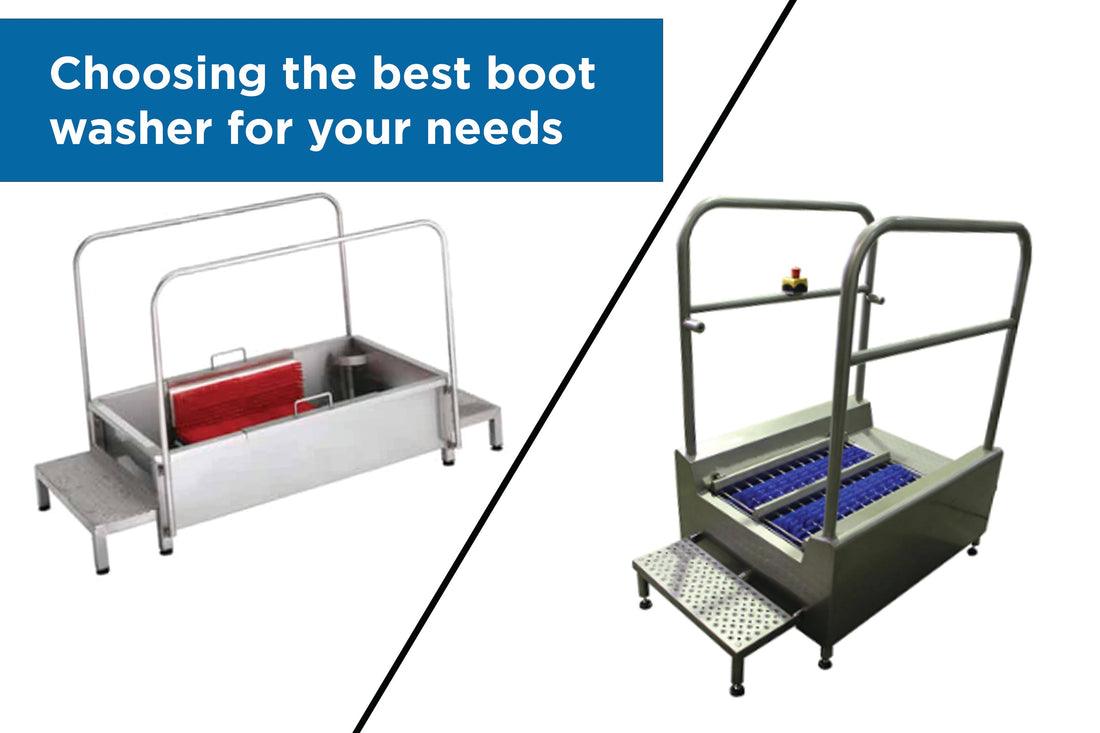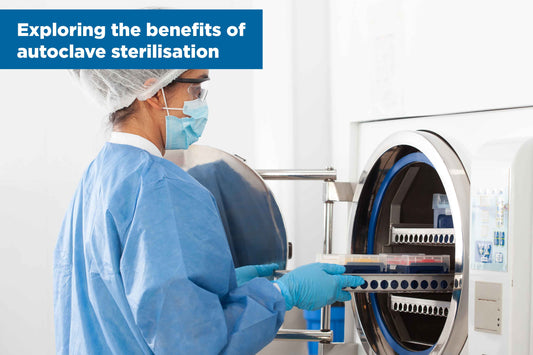Boot washers are essential tools for maintaining hygiene standards, reducing cross contamination and enhancing operational efficiency within hygienic environments. Available in both motorised and manual systems, they ensure hygiene protocols are followed consistently and efficiently among staff. They also assist with sustainability measures thanks to controlled use of water and cleaning agents.
From sole-focused sanitisation to full boot cleaning using sole and side brushes, we offer a variety of manual and motorised boot washers to choose from, but which is best for your needs? In this blog, we will discuss our range of boot washers and how they can assist with your hygiene practices.

Manual boot washers
Without the need of a power supply, manual boot washers can be a more cost-effective option for businesses with tighter budgets or lower volumes of foot traffic. Thanks to this, they also offer more flexibility with the ability to be placed and moved to various locations without the concern of wiring or nearby electrical sockets. Featuring fewer mechanical parts and a simple design, they are easy to maintain with a reduced risk of breakdown or repair.
Arguably, the biggest advantage of manual boot washers is that they give staff direct control over the cleaning process. This allows workers to focus more on cleaning problem areas of their footwear that may be worse for collecting dirt, however it can cause varying results across the workforce depending on how thorough or rushed they are.
Advantages and disadvantages when compared to motorised models
Advantages
- Cost - cheaper to run, maintain and repair than motorised models.
- Simplicity - easy to install and use with minimal training required.
- Flexible - can be placed anywhere without the need for an electrical supply.
Disadvantages
- Effort - results rely on the effort from employees.
- Slower process - manual washers are better than motorised models for smaller staff flows.
- Inconsistency - it relies on the thoroughness of the user which can lead to varying levels of cleanliness.

Motorised boot washers
Offering a faster cleaning process, motorised boot washers are ideal for high-traffic areas and large facilities. This equipment provides consistent results across the workforce with the machine following a set cleaning routine that reduces the risk of negligence and human error.
Many of our motorised boot washers also allow a tailored approach with the ability to adjust both the amount of washer solution used and the duration of the cleaning process. This not only assists sustainability efforts, but also staff efficiency while preventing a bottleneck as workers progress to the next area.
Advantages and disadvantages when compared to manual models
Advantages
- Time-saving - providing a faster cleaning process than manual options, it allows more staff to pass through and clean their boots quickly.
- Consistency - it reduces the risk of human error or insufficient cleaning.
- Efficiency - it offers consistent and thorough cleaning using automated brushes and jets.
Disadvantages
- Complexity - motorised models have a more complex installation and maintenance process.
- Energy Use - these models require electricity. This can add to running costs as well as result in potential downtime during power outages.
What maintenance is needed?
Boot washers should be cleaned after every shift to prevent the build-up of grime and bacteria. The levels of cleaning agents and disinfectants should also be checked regularly to ensure that there is no risk of running out during the washing process.
We recommend having spare brushes to hand so that the equipment can still be functional while the original brushes are being cleaned. We offer replacement brushes (sold separately) to ensure that high hygiene standards are always maintained.

Which should you pick?
The one you choose really depends on your specific needs. Motorised boot washers are usually best for larger facilities with high foot traffic. Keeping cleaning consistent for each staff member, they are ideal for areas where stringent hygiene standards are imperative.
In comparison, manual boot washers are more beneficial for smaller operations or facilities facing particular budget constraints. They are also ideal for temporary setups or areas where access to power supply is limited.
If your hygienic environment uses shoes rather than boots, then a sole washer may also be an appropriate option. This equipment focuses only on the sole of the shoe and usually takes up less space due to a lack of rails (unless a walk-through variant is selected) making it well-suited for facilities with limited room. These are best suited for areas with a lower contamination risk where outdoor contaminants are the main concern rather than the removal of dirt and debris.
To assist with your purchase, we’ve created a handy buying guide to help you select the right boot washer for your needs.
Still not sure? Our friendly team of experts are on hand to help! Just call +44 (0)1603 788 833 or email mail@teknomek.co.uk today.




